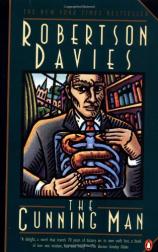Reading Group Guide
Discussion Questions
The Cunning Man

1. The story of Dr. Hullah's life and times emerges in reaction to a series of interviews with the young journalist Esme Barron. What does she add to the story? What happens to shift Hullah from his initial mistrust of her to "love?"
2.The Cunning Man turns on Father Ninian Hobbes' death. The event is recounted at length three times, at the beginning by Dr. Hullah, in III:18 in a letter by Miss Todhunter, and in IV:21 by Charlie Iredale, and it is referred to more briefly again and again. Why is the old priest's death given such prominence?
3.Interspersed through the third section of the novel are letters written by Miss Pansy Freake Todhunter ("Chips") to the English sculptor Barbara Hepworth. Chips and her companion, Emily Raven-Hart, observe The Toronto That Used to Be using the standards they had absorbed in Britain. Consider what the letters add to the story.
4. Contrast Davies' view of Toronto's cultural life in the thirties, forties, and fifties with the cultural life of a mid-sized U.S. city during that period.
5. Dr. Hullah has Emily Hart-Raven sculpt a four-foot tall version of the caduceus, the symbol of medicine, for the wall at the entrance to his clinic. This, we are told, is "Hermes' walking-stick with two snakes curling around it." Why does Hullah specify a pair of Massassauga rattlers? Why does Davies link this Greek mythic symbol to Canadian Indian lore?
6.The first section of the novel describes a discussion at the Curfew Club at Colborne College, where the supporters of religion (Dunstan Ramsay and Charlie Iredale) confront the advocates of science (Evans). Why does Davies include this scene? Where do you think Hullah stands?
7.At the end of this scene Dunstan Ramsay argues that "The truly historical view was not a tale of man's progress from barbarism or superstition to modern enlightenment, but a recognition that enlightenment had shown itself in the long story of man in a variety of guises, and that barbarism and superstition were undying elements in the human story." How is this observation evinced by the novel?
8. As readers of Murther & Walking Spirits know, that novel begins with the murder of Esme Barron's husband, Connor Gilmartin. There, the man who killed Gilmartin eventually confesses to Hugh McWearie, just as, in The Cunning Man, Charlie Iredale eventually confesses to Jonathan Hullah. In a scene near the end of The Cunning Man McWearie and Hullah exchange secrets, each confirming what the other suspected. What makes us accept their insights? Why is this scene so satisfying?
9. In the last section of The Cunning Man, Dr. Hullah, now sixty-five, decides to give his life fresh interest by engaging in a new form of literary criticism. He will "apply modern medical theory to the notable characters of literature" and call the resulting book The Anatomy of Fiction. This project produces a series of "Notes for ANAT." each one a literary excursion inspired by something in the main story. What effect do these literary asides have on you as the reader? Do they distract you from the main story? Are they in some sense part of the story? Does Davies want a slower pace and if he does, why? and does he carry you with him?
The Cunning Man
- Publication Date: February 1, 1996
- Paperback: 480 pages
- Publisher: Penguin (Non-Classics)
- ISBN-10: 0140248307
- ISBN-13: 9780140248302






